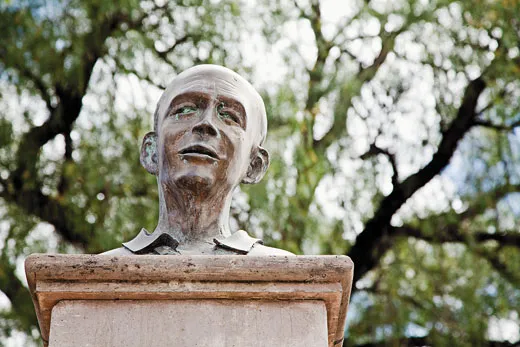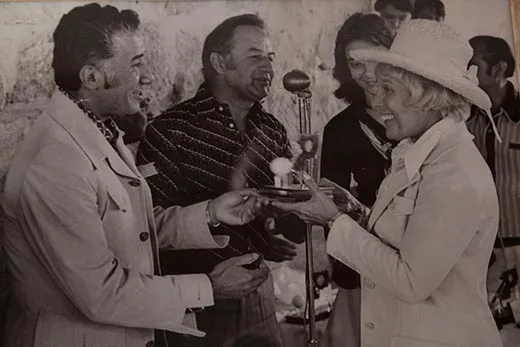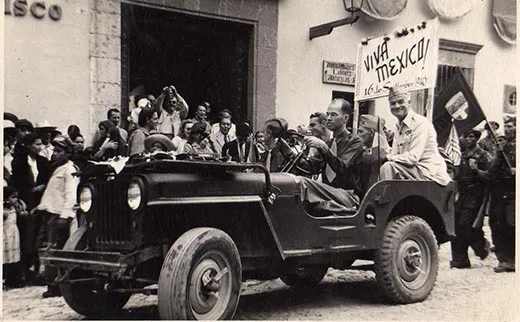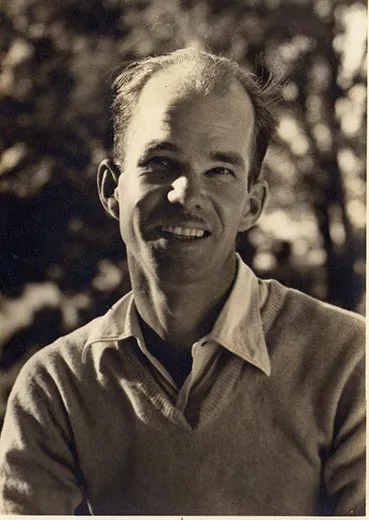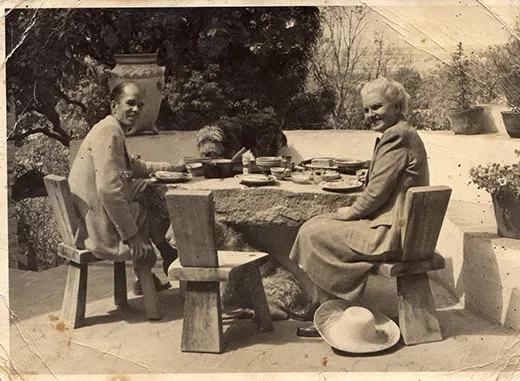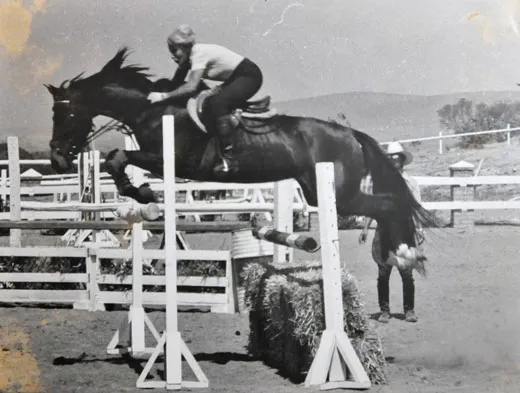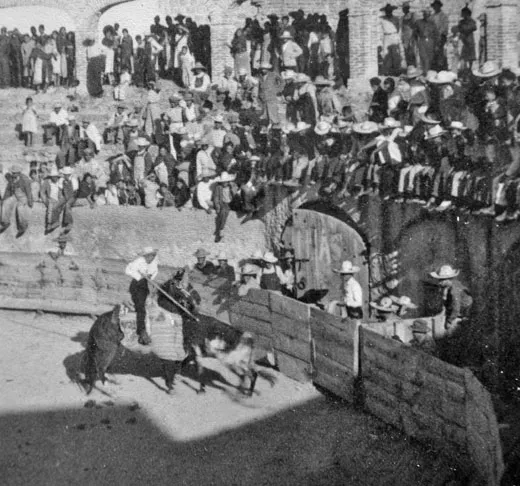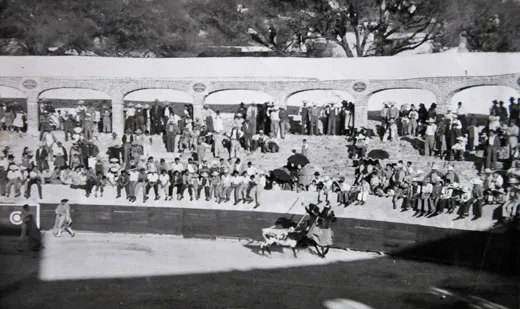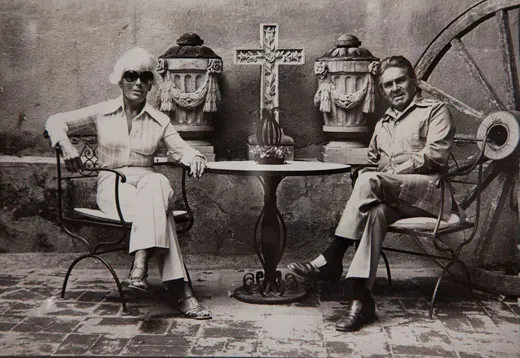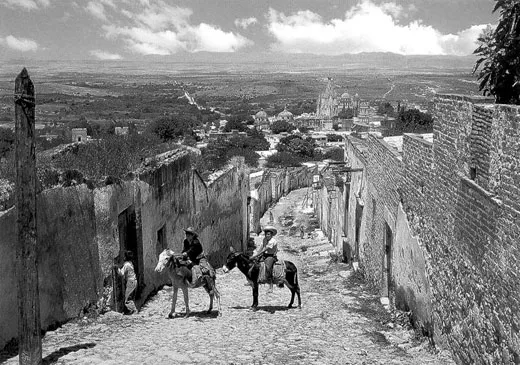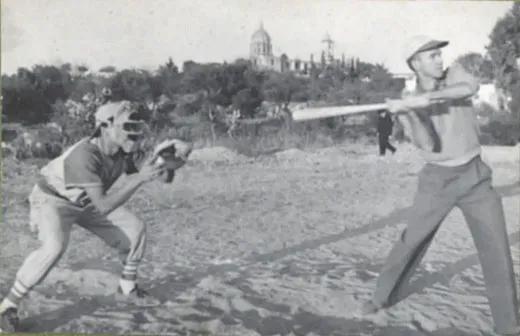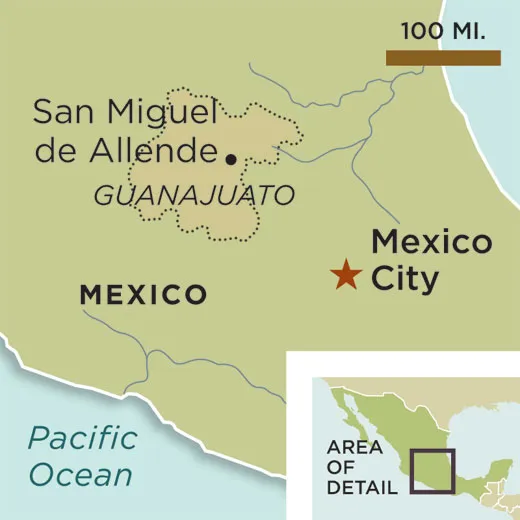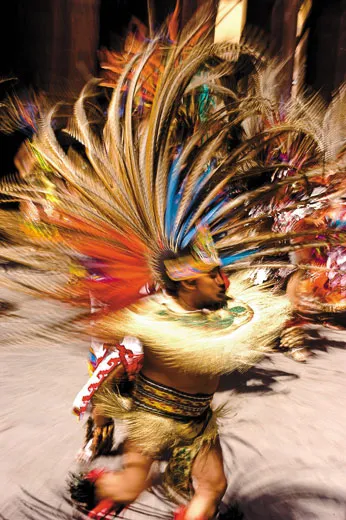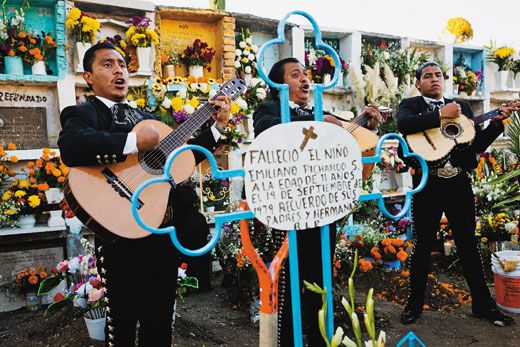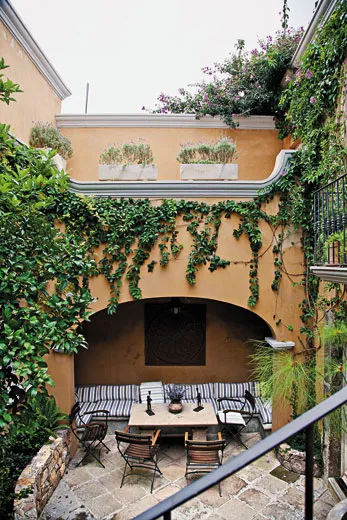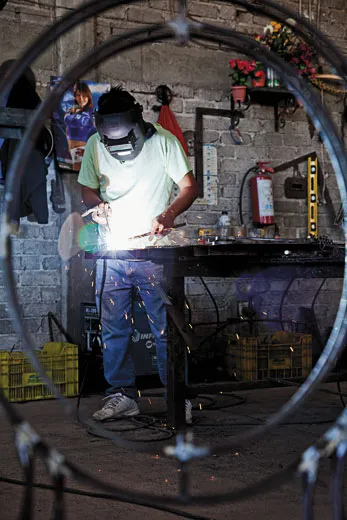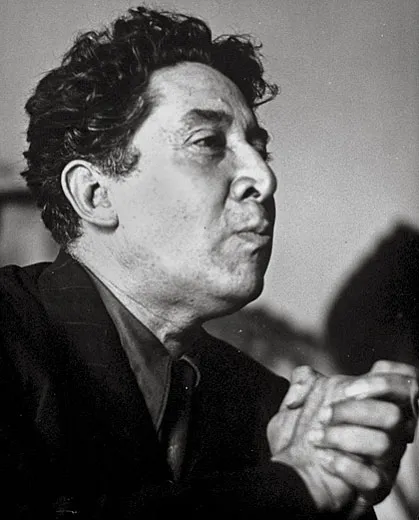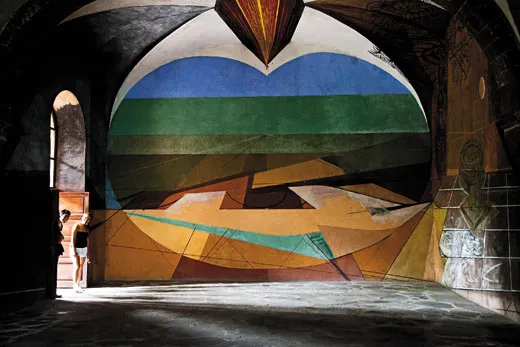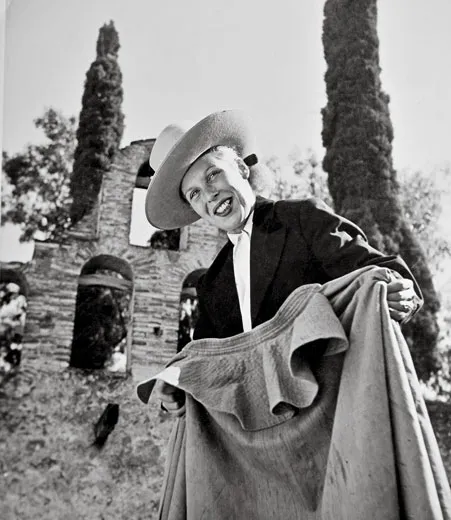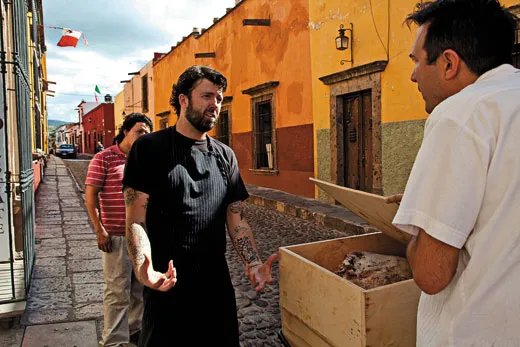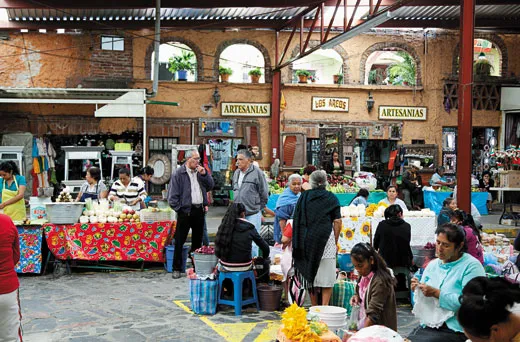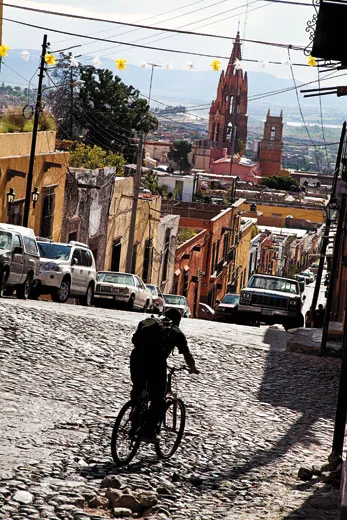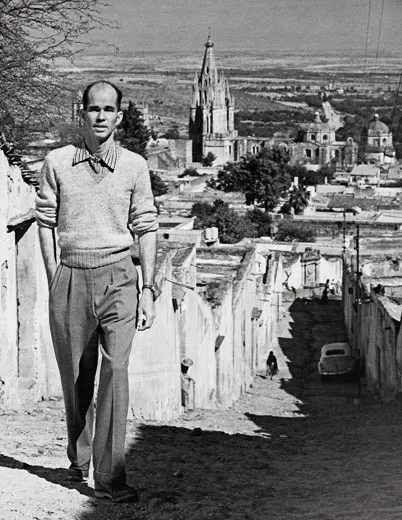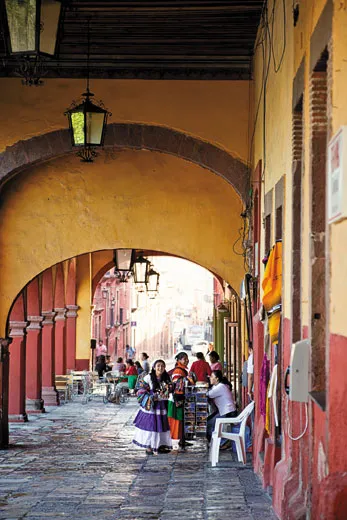Under the Spell of San Miguel de Allende
Ever since American Stirling Dickinson arrived there in 1937, the Mexican town has been a magnet for artists and U.S. expatriates
/https://tf-cmsv2-smithsonianmag-media.s3.amazonaws.com/filer/San-Miguel-town-631.jpg)
In 1937, after several months spent traveling through Mexico, a gangly, 27-year-old Chicago native named Stirling Dickinson, who had been somewhat at loose ends since graduating from Princeton, got off a train in San Miguel de Allende, an arid, down-on-its-luck mountain town 166 miles northwest of Mexico City.
Taken from the ramshackle train station by a horse-drawn cart, he was dropped off at the town's leafy main square, El Jardín. It was dawn, and the trees were erupting with the songs of a thousand birds. At the eastern side of the square stood the Parroquia de San Miguel Arcángel, an outsize, pink-sandstone church with neo-Gothic spires, quite unlike Mexico's traditional domed ecclesiastical buildings. The first rays of the sun glowed over mountain ridges to the east. "There was just enough light for me to see the parish church sticking out of the mist," Dickinson would later recall. "I thought, My God, what a sight! What a place! I said to myself at that moment, I'm going to stay here."
Founded in 1542, the settlement of San Miguel had grown rich from nearby silver mines during centuries of Spanish rule, then fell on hard times as the ore was depleted. By the time Dickinson got there, the War of Independence from Spain (1810-21) and the even bloodier Mexican Revolution (1910-21) had further reduced the town to 7,000 inhabitants—less than a quarter of its population in the mid-1700s. Houses languished in disrepair, with shattered tile roofs and crumbling, faded walls.
Dickinson made his home in a former tannery on San Miguel's higher reaches and soon became a familiar sight, riding around town on a burro. For the next six decades, until his death in 1998, he would lead a renaissance that would transform tiny San Miguel into one of Latin America's most magnetic destinations for artists and expatriates, most of them American, looking for a new venue—or a new life.
"Stirling Dickinson is without doubt the person most responsible for San Miguel de Allende becoming an international art center," says John Virtue, author of Model American Abroad, a biography of Dickinson. Although only an amateur painter himself, Dickinson became co-founder and director of the Escuela Universitaria de Bellas Artes, an art institute that he opened in a former convent only a few months after his arrival.
During World War II, Dickinson served with U.S. Naval Intelligence in Washington and the Office of Strategic Services (forerunner of the CIA) in Italy. Returning to San Miguel after the war, he recruited hundreds of young American veterans to study at Bellas Artes on the G.I. Bill of Rights.
In the postwar years, non-artists and retirees, as well as painters and sculptors, were drawn to the city from its neighbor to the north; today, some 8,000 Americans—one out of ten residents—live there. Eighty percent or so are retirees; the others oversee businesses, from cafés and guesthouses to galleries and clothing stores. Most of these expats—some of whom have Mexican spouses—volunteer at more than 100 nonprofit organizations in San Miguel, including the library and health care clinics.
"This mestizaje—cultural mixing—has profoundly changed and benefited both sides," says Luis Alberto Villarreal, a former mayor of San Miguel who is currently one of two senators from the state of Guanajuato, in which the town is located. "We owe a huge debt of gratitude to Stirling Dickinson for helping this come about and for raising San Miguel's profile in the world." Walking the cobblestone streets flanked by stucco houses painted vivid shades of ocher, paprika and vermilion, one passes lively squares full of street musicians and vendors hawking tacos. In the distance rises the Sierra de Guanajuato. In 2008, San Miguel was designated a UNESCO World Heritage site, in large measure because of its intact 17th- and 18th-century center.
While mass murder and kidnapping linked to narcotics gangs have overtaken parts of Mexico, the region around San Miguel has thus far been spared. "The cartels' violence often centers on ports of entry into the U.S. and involves consolidation of contested border areas," says Rusty Payne, spokesman for the U.S. Drug Enforcement Agency. "San Miguel does not fit these criteria."
Dorothy Birk—today Dotty Vidargas—was among the first of the young Americans to answer Dickinson's call, in 1947. Six decades later, at age 85, she oversees a real estate agency and furnishings store across from an 18th-century church.
Vidargas grew up in Chicago, a block away from Dickinson. She says he had three passions: art, baseball and orchids. At Bellas Artes, she recalls, he formed a baseball team that won 84 games in a row and captured several regional amateur championships in the 1950s. He traveled throughout Mexico and the world to collect wild orchids, breaking three ribs in a fall during a 1960s expedition to southern Mexico's Chiapas highlands. An orchid he discovered there in 1971 was named after him—Encyclia dickinsoniana.
In 1942, in her sophomore year at Wellesley College, Vidargas left academia to enlist in the war effort, eventually serving as a Navy recruiter and, later, as an air controller for the Army Air Forces outside Detroit. After the war, she enrolled at the American Academy, an art institute in Chicago. But in 1947 she decided to spend her G.I. Bill subsidies in San Miguel. "My mother knew Stirling and figured it would be all right for me to go," she says.
She was one of 55 veterans accepted at Bellas Artes that year. More than 6,000 veterans would apply to the school after the January 1948 issue of Life magazine called it a "G.I. Paradise," where "veterans go...to study art, live cheaply and have a good time."
But Vidargas' first impression was well this side of paradise. Arriving by train in the pre-dawn darkness, she checked into a hotel where electricity and running water were sporadic. Many of the surrounding buildings were near ruins. Burros outnumbered cars; the stench of manure and raw sewage was overpowering. "I was cold, miserable and ready to board the next train home," she recalls. But she soon found more comfortable student lodging and began her Bellas Artes course work. Between school terms, she traveled with fellow students and Dickinson throughout Mexico.
She even joined the local bullfighting circuit as a picador, or horseback-mounted lancer. "It was after a few drinks, on a dare," Vidargas recalls. Soon "la gringa loca" ("the crazy Yank"), as she was becoming known, was spending her weekends at dusty bullrings, where her equestrian prowess made her a minor celebrity.
Meanwhile, some members of the town's conservative upper class were outraged by the American students' carousing. The Rev. José Mercadillo, the parish priest, denounced the hiring of nude models for art classes and warned that the Americans were spreading Protestantism—even godless Communism.
In fact, in 1948, Dickinson recruited the celebrated painter David Alfaro Siqueiros, a Communist Party member, to teach at Bellas Artes. There he lashed out at his critics, far exceeded his modest art-class budget and eventually resigned. Siqueiros left behind an unfinished mural depicting the life of local independence leader Ignacio Allende, whose last name had been appended to San Miguel in 1826 to commemorate his heroism in the war. The mural still graces the premises, which today is occupied by a cultural center.
Apparently convinced that Communists had indeed infested Bellas Artes, Walter Thurston, then the U.S. ambassador to Mexico, blocked the school's efforts to gain the accreditation necessary for its students to qualify for G.I. Bill stipends. Most of the veterans returned home; some were deported. Dickinson himself was expelled from Mexico on August 12, 1950, although he was allowed back a week later. "It was the low point in relations between Americans and the locals," recalls Vidargas. "But my situation was different, because I got married."
José Vidargas, a local businessman, who today is 95, had met his future bride at a bowling alley, one of many postwar fads to invade Mexico from the United States. Some of his relatives wondered about his plans to marry a gringa. "Suddenly, I had to become a very proper Mexican wife to be accepted by the good society families," recalls Dorothy. The couple had five children in seven years, and Dorothy still found time to open the first store in San Miguel to sell pasteurized milk; the real estate agency came later. Today, three sons live in San Miguel; a daughter lives in nearby León; one child died in infancy.
By 1951, the various controversies had closed down Bellas Artes, and Dickinson became director of a new art school, the Instituto Allende, which soon became accredited and began granting Bachelor of Fine Arts degrees. Today, the nonprofit school, attended by several hundred students annually, encompasses a fine-arts degree program, a Spanish-language institute and traditional handicraft workshops.
In 1960, Jack Kerouac, the novelist who had catapulted to fame three years earlier with the publication of On the Road, went to San Miguel with pals Allen Ginsburg and Neal Cassady. Ginsburg read his poetry at the Instituto Allende, while Kerouac and Cassady spent most of their time downing tequilas at La Cucaracha, a traditional Mexican cantina that remains popular to this day. The trio remained only a few days, but in 1968, Cassady returned to San Miguel, where he died at age 41 from the effects of alcohol, drugs and exposure.
The plaintive recordings of Pedro Infante, still Mexico's most popular country singer more than a half century after his death, can be heard most mornings at San Miguel's largest traditional food market, the Mercado Ignacio Ramírez. Vendors display varieties of chile, red and green prickly pears, black and green avocados, orange and yellow melons, tropical fruits including mamey, with its pumpkin-hued flesh, and guayaba, whose texture resembles a white peach. Nopales (cactus leaves shorn of spines) are stacked alongside Mexican herbs, including epazote, used to flavor black beans, and dark red achiote seeds, an ingredient in pork and chicken marinades.
"I love the presentation of the food stands," says Donnie Masterton, 41, chef and co-owner of the Restaurant, arguably San Miguel's top culinary establishment. He is shopping at the market for that evening's eclectic menu: a chilled cauliflower soup with lemon grass and shrimp; duck with mole negro (a complex sauce based on chiles and herbs) and handmade tortillas; churros (a pencil-length fried-dough pastry) with dark Mexican chocolate pot-de-crème (a creamy custard). More than half the diners will be residents—Mexican, American and Canadian; the rest will be foreign or Mexican visitors. "It definitely won't be the same food they will get back in New York or Los Angeles," Masterton promises.
A Los Angeles native, Masterton settled in San Miguel six years ago, drawn by its beauty and the opportunity to own his own restaurant. The Restaurant occupies an inner courtyard under a retractable glass roof. "I wanted a seasonal menu with as many locally grown ingredients as possible," says Masterton. To meet his own standards, he purchased a quarter acre inside an organic farm outside San Miguel, where farmers harvest produce grown from seed: Swiss chard, bok choy, mache and arugula. His biggest complaint is the lack of fresh fish. "The quality is inconsistent," says Masterton. "I'm exploring the idea of phoning a fishing boat off the Pacific coast to order the fresh catch of the day."
Cheryl Finnegan came to San Miguel in 2000 from San Francisco, where she had spent 14 years in the marketing department of Levi Strauss, the jeans and casual wear manufacturer. "One day I woke up and asked—Where is my passion? I had no passion," she recalls. "So I just dropped everything—my marriage, job, home, box seats at the opera—and moved down here."
A chance occurrence launched her new career. A decade ago, she was vacationing in the Mexican village of Sayulita, some 35 minutes north of Puerto Vallarta on the Pacific coast, during the annual December 12 celebration of the Virgin of Guadalupe. (The festival commemorates the day in 1531 when the Virgin Mary is said to have appeared on the outskirts of Mexico City.) As Finnegan strolled the town's central square, a fragment of fireworks hit her in the throat. A local doctor told her she would be permanently scarred. "The wound was shaped in the silhouette of [Our Lady of] Guadalupe, and when I walked around Sayulita, the villagers said it was a sign that I was her chosen one," says Finnegan. "Two weeks later, the wound disappeared without a scar—the doctor couldn't believe it!"
What remained was an obsession with the Virgin of Guadalupe. Finnegan began designing key chains, cameos, rings and belt buckles with the Virgin Mother's image, coated in resin and decorated with crystals. In 2004, paparazzi in the United States photographed pop singer Britney Spears wearing one of Finnegan's belts. "It put me on the map," says Finnegan. Other singers—Tim McGraw and Shakira—have sported Finnegan buckles.
Today she employs ten women to help run her jewelry and clothing accessories firm, housed in a restored 18th-century residence near the town center. Her designs, bearing tags with New Age slogans—"Everybody needs a miracle once in a while"—are sold throughout the United States, Europe and Asia under the name Virgins, Saints & Angels.
Jorge Almada, 37, is the grandson of Plutarco Elías Calles, a revolutionary general who served as president of Mexico in the 1920s. Almada and his French-American wife, Anne-Marie Midy, 38, met in New York City. After traveling across Mexico in search of artisan-made furnishings, the couple settled in San Miguel in 200o and began designing furniture to export to the United States and Europe under the Casamidy brand. "There is great artistry throughout Mexico," says Almada. "But we found San Miguel artisans to be the most open-minded and receptive to designer suggestions."
Refugio Rico García, 64, an ironsmith, is among the artisans employed by the couple. He lives and works in the same house in which he was born. The residence, a warren of rooms and tiny patios verdant with potted plants, scales a steep hillside. Photographs of his grandparents, faded to sepia, greet visitors in the foyer. "My grandfather was a potter—[he produced] pots and also sewage pipes, which used to be made of clay," says García. "He was the one who got me interested in becoming an artisan." (García's sons reject the life of an artisan as too lonely and demanding. The elder boy is a migrant worker in Arizona; the younger is a student.)
García labors up to 14 hours a day. The walls and ceiling of his workshop are blackened from the charcoal fires that fuel his forge. Near the furnace stands a heavy wooden table fitted with an iron plate; here he hammers half-molten metal into various shapes. García produces headboards for beds, chandeliers, and chairs and tables fitted with glass tops for Almada and Midy.
The Hotel Oasis, a restored 18th-century house with four guest rooms, features Casamidy tables and chairs in an interior designed by Hong Kong-born Leslie Tung, a San Miguel decorator, and hotel owner Nancy Hooper. A native New Yorker and former Texas resident, Hooper acquired the property in 2006.
Widowed in the 1990s, Hooper decided to spend a summer in San Miguel with her teenage daughter, Tessa. "I wanted her to feel that life goes on and to give her a sense of new adventure," she says. In 2000, Hooper moved to San Miguel from Texas. She was intrigued by an abandoned house and a spacious room she could see through a window as she walked by. "It just wouldn't leave me alone—I knew I wanted to turn it into a hotel," says Hooper, who had no experience as an innkeeper. "From the beginning, I envisioned an oasis—a place where visitors to San Miguel could get away from the bustling outside."
By the early 1980s, Dickinson had begun to distance himself from the growing number of Americans. "Stirling must have shuddered the day he saw the first tourist bus arrive in San Miguel and disgorge tourists wearing shorts," wrote biographer Virtue. "These were exactly the type of people he railed against in his own travels abroad." In 1983, Dickinson resigned as director of the Instituto Allende, where, during his 32-year tenure, some 40,000 students, mainly Americans, had matriculated. Increasingly involved with the Mexican community, he oversaw a rural library program that donated volumes from San Miguel residents to village schools. He also began to support financially the Patronato Pro Niños—the Pro-Children Foundation—an organization providing free medical service and shoes for impoverished rural youngsters.
On the night of October 27, 1998, the 87-year-old Dickinson was killed in a freak accident. As he prepared to drive away from a Patronato Pro Niños meeting held at a hillside house, he accidentally stepped on the gas pedal instead of the brake. His vehicle plunged down a steep embankment; Dickinson died instantly. More than 400 mourners, including foreigners and Mexicans from the countryside, attended his funeral. He was buried in the foreigners' section of Our Lady of Guadalupe Cemetery, just west of San Miguel's center. Today, a bronze bust of Dickinson stands on a street bearing his name.
The Guadalupe Cemetery attracts huge throngs on November 2, the Day of the Dead, when families of the deceased carry food and other gifts to their relatives' graves. "One brings what the dead liked best in life—liquor, cigarettes, especially a favorite food," says Dehmian Barrales, a local anthropologist. "It's a bit like a birthday party, and the family is saying to the dead: 'Here are your presents; we are here to keep you company.' The idea is to leave the food long enough for its essence to be consumed by the dead; its material form can be eaten by the living."
On a sunny November morning at the Guadalupe Cemetery, crowds shuffled through the white-walled entrance. Graves were festooned with orange cempasúchil blossoms, cut only on the Day of the Dead. Photographs of loved ones were propped against headstones. At one grave, a priest hired by relatives led prayers and psalms. At another, a mariachi band belted out the deceased's favorite Pedro Infante ballads, while relatives feasted on barbecued pork tacos and glasses of tequila that the dead had "left over."
The foreigners' section of the cemetery was empty of visitors, except for a small contingent of Mexicans and elderly Americans who clustered around a memorial fountain dedicated to Dickinson. The fountain, near his burial site, commands a view of the other graves. "He is watching over them," said Jorge Antonio Ramírez, 80, a retired Bellas Artes employee and former Dickinson baseball player, who had brought a cempasúchil bouquet to commemorate his friend. "Just like he always did in life."
Jonathan Kandell lives in New York City. Photographer Ann Summa is based in San Miguel de Allende and Los Angeles.
